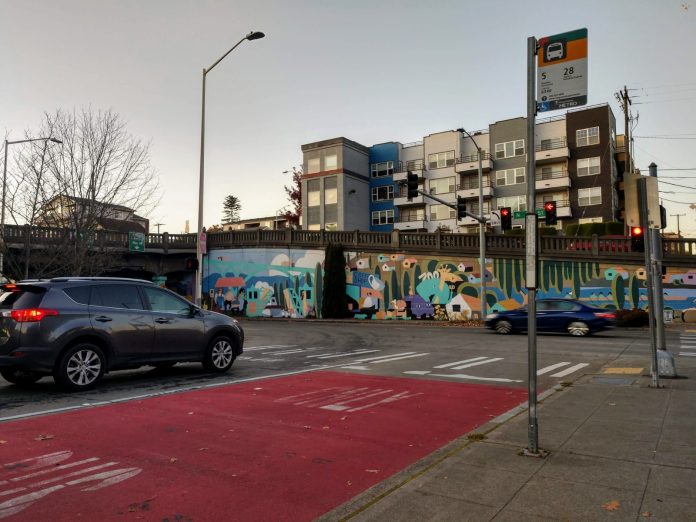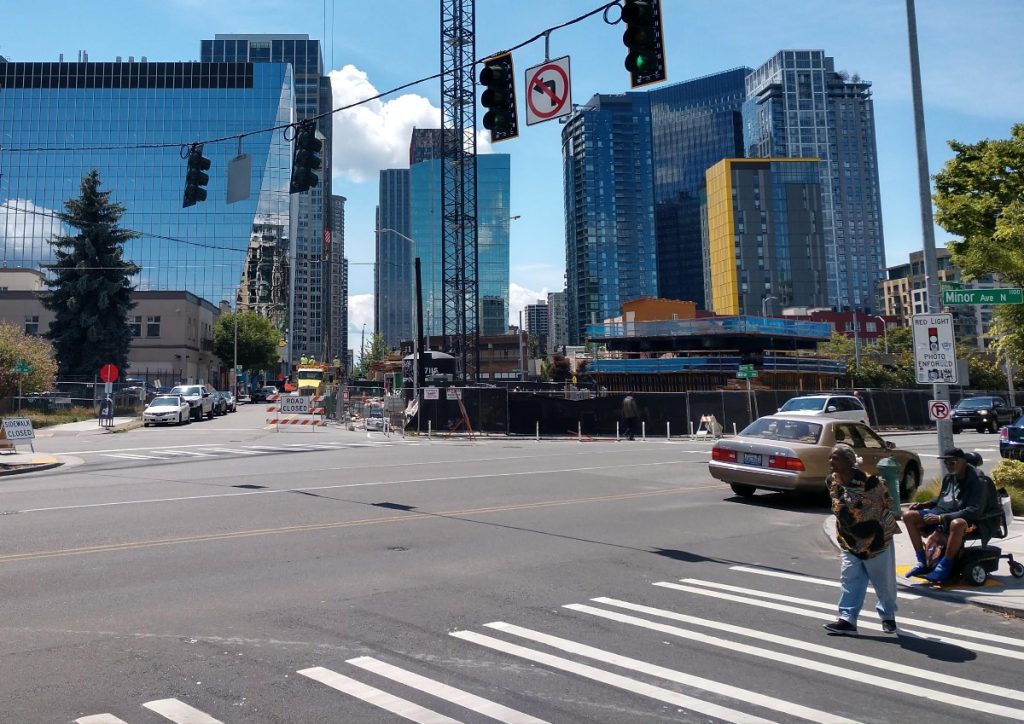
Legislation to expand the use of camera enforcement is back. Senator Marko Liias (D-Edmonds) has taken up the torch this year after camera enforcement legislation fizzled out in the state senate last year despite passing the state house. The bill would allow Seattle to use camera enforcement to reduce blocking violations of intersections, crosswalks, and bus lanes–but limits crosswalk enforcement to 20 intersections, lowers fines to $75, and authorizes only a three-year pilot program. The bill has only had a public hearing so far, but will likely move through the committee process in the next few weeks before floor votes in both state legislative chambers.
On Tuesday, Senator Liias laid out his case for expanded camera enforcement in Seattle from the perspective of a legislator who does not live in Seattle. “The traffic conditions in the downtown core are unlike any other part of the state that I travel in,” he said. “The density of traffic, the types of vehicles that are moving around the intersection of pedestrians and bicycles means that there are more conflict and more chaos than anywhere else.”
Senator Liias highlighted two main issues that he hopes the bill resolve: blocking intersections and bus lanes. A friend of his recently told him about being stuck at intersection for four light cycles because of the intersection being blocked by cars sitting in the middle of it. He also said that bus lane violations keep his constituents who ride buses delayed.
Washington legislators tried to pass similar bills in the past two years. In 2018, Representative Gael Tarleton (D-Seattle) was a chief champion of the first version, but it never got out of the lower house. Then in 2019, Representative Joe Fitzgibbon (D-Seattle) took another run at the issue, getting the bill out of the lower house. But the bill never made it to senate floor, primarily due to differing opinions by Democratic senators from within the caucus who were not happy with the scope of provisions and feared they themselves would be facing fines, according to a very candid Senator Joe Nguyen (D-Seattle).
The Senate Transportation Committee held a hearing Tuesday on a substitute version of SB 5789, which was similar to the bill seen by the Washington State Senate last year. (Here’s a list of state legislators with contact information for those interested in submitting comment.)
As proposed, the substitute bill would allow Seattle to use camera enforcement for violations involving stopping in an intersection, blocking a crosswalk, or stopping or driving in a bus lane or restricted lane. All cities besides Seattle would continue to be barred from those new uses of camera enforcement. Cameras can be used at the intersection of two or more arterials or at midblock locations on arterials. Seattle’s new authority would come with certain restrictions, such as:
- Camera enforcement would be limited in geographic scopes to the following areas: streets in Downtown Seattle, streets a half-mile north of Downtown Seattle, SR-99 for a distance of four miles north of Downtown Seattle, and streets that connect to those SR-99 portions within one mile;
- Camera enforcement of crosswalk and intersection violations would be limited to 20 intersections;
- Camera enforcement cannot be used on any on-ramp to an interstate highway; and
- Warnings with no penalties may only be issued through December 31, 2020.
Beginning on January 1, 2021, Seattle could begin issuing citations for violations. The citations would be limited to $75 fines with the state and city sharing in revenues. The state would receive 50% of the revenues generated from the program after accounting for costs to install, operate, and maintain the cameras. This likely means early in the program, all of the revenue will go to the city to pay for operations and initial installation costs. Any revenue that Seattle keeps, after accounting for the state’s share and operations, will have to be spent on accessibility improvements for people with disabilities. That is generally understood to be the installation and upgrade of curb ramps, but it is possible other accessibility improvements could be funded.

The bill includes safeguards for transit operators and commercial freight operators. Any citations or warnings issued for violations committed by a transit operator on duty could not be used to terminate the employee. Commercial freight operators with vehicles weighing at least 10,000 pounds would be able to contest a citation and present mitigating information for why the violation should be vacated.
The bill also specifies reporting requirements. A preliminary report on the pilot program performance and other evaluation data would need to be sent to the state legislature by June 30, 2022, and a final report would need to be delivered by January 1, 2023, just before the start of the 2023 legislative session. However, the pilot program would be scheduled to terminate the same day, so absent prior reauthorization in 2022, enforcement cameras would have to be turned off until the state legislature granted a program extension.
Kelsey Mesher, Advocacy Director at Transportation Choices Coalition, said that her organization supports the bill, but felt that additional flexibility should be provided in where camera enforcement is allowed. Limiting the scope of eligible locations so narrowly, she said, could reduce the effectiveness of pilot program and ultimately its performance, which will be evaluated by the legislature in 2023.
City officials also expressed their support. “Blocking the box creates a cascading effect of congestion in downtown urban cores,” said Seattle Councilmember Dan Strauss. “Unless we want to use our uniformed officers for enforcement of transit only lanes, we will not move the freight of people through the city. There are higher and better uses of our uniformed officers in our city.”
Councilmember Strauss was joined by Seattle Fire Department Chief Harold Scoggins and Seattle Police Department Captain Sean O’Donnell who reiterated the benefit of camera enforcement for these types of violations instead of using uniformed officers. They said that it would aid public safety with fewer threats to people walking, rolling, and biking at intersections, keep streets clearer for first responders, and enable police to address other priorities.
Representatives of the disability rights group Rooted in Rights–which also led the charge last session–testified that ensuring crosswalks are clear is a life or death matter and essential to the mobility of disabled people. “Pedestrians in wheelchairs are 33% more likely to die in crashes,” said Clark Matthews, Lead Producer with Rooted in Rights. “When drivers block curb cuts or intersections, it creates dangerous situations for me,” Blake Geyen added. “Drivers cannot always see me, nor do they expect wheelchair users to be in the middle of the street trying to cross.”
Predictably, Senate Republicans on the transportation committee presented many car rights arguments. They spent time blaming people who walk, roll, or bike for creating congestion and the violations motorists pay. They wondered how people would get to and from cultural venues without the impunity to commit traffic violations. They theorized that the fines might make people think twice about driving through Seattle.
Matthews made a clever counterpoint though: “The only argument I’ve heard against this bill is that it might actually work.”
Doug Trumm is publisher of The Urbanist. An Urbanist writer since 2015, he dreams of pedestrianizing streets, blanketing the city in bus lanes, and unleashing a mass timber building spree to end the affordable housing shortage and avert our coming climate catastrophe. He graduated from the Evans School of Public Policy and Governance at the University of Washington in 2019. He lives in East Fremont and loves to explore the city on his bike.


